
Winston Churchill once said, “To improve is to change; to be perfect is to change often.” If he’d had to deal with modern IT environments, he might have reconsidered.
The world of IT deals with enormous challenges, many of them to do with too much change, too fast. IT is being asked to add new systems, rip out old ones, move everything to the cloud tomorrow, make sure everything is virtualized, refresh all the servers and PCs, and of course digitalize the entire infrastructure and enact endless security provisions across all systems.
This of course is impossible. Nevertheless, it is largely what is being demanded. Regardless of how much or how little of the IT shopping list is being implemented, there is a phenomenal amount of change occurring. Change management tools are an attempt to bring some sanity to the wild world of changing IT.
Read more: What Is IT Change Management?
Best Change Management Tools
There are a wide variety of choices out there when it comes to change management software, tools, and platforms. Some are very specific to change, others provide complete suites for many aspects of IT management. CIO Insight evaluated a number of them. Here are our top picks, in no particular order.
ServiceNow Change Management
ServiceNow Change Management is a single, unified platform to track and manage all changes occurring across technology teams. It offers depth of functionality to help change submitters, change managers, and approvers. Its goal is to simplify all ends of the change management spectrum, so that changes can flow quickly and easily through the system without giving up audit control or increasing risk.
ServiceNow enables native integrations to tools that allow for quick and easy root cause analysis should a change break something. Further, the platform offers built-in machine learning that approves changes and provides integration with vulnerability response, IT operations, and other IT processes, as well as being ready for DevOps environments.
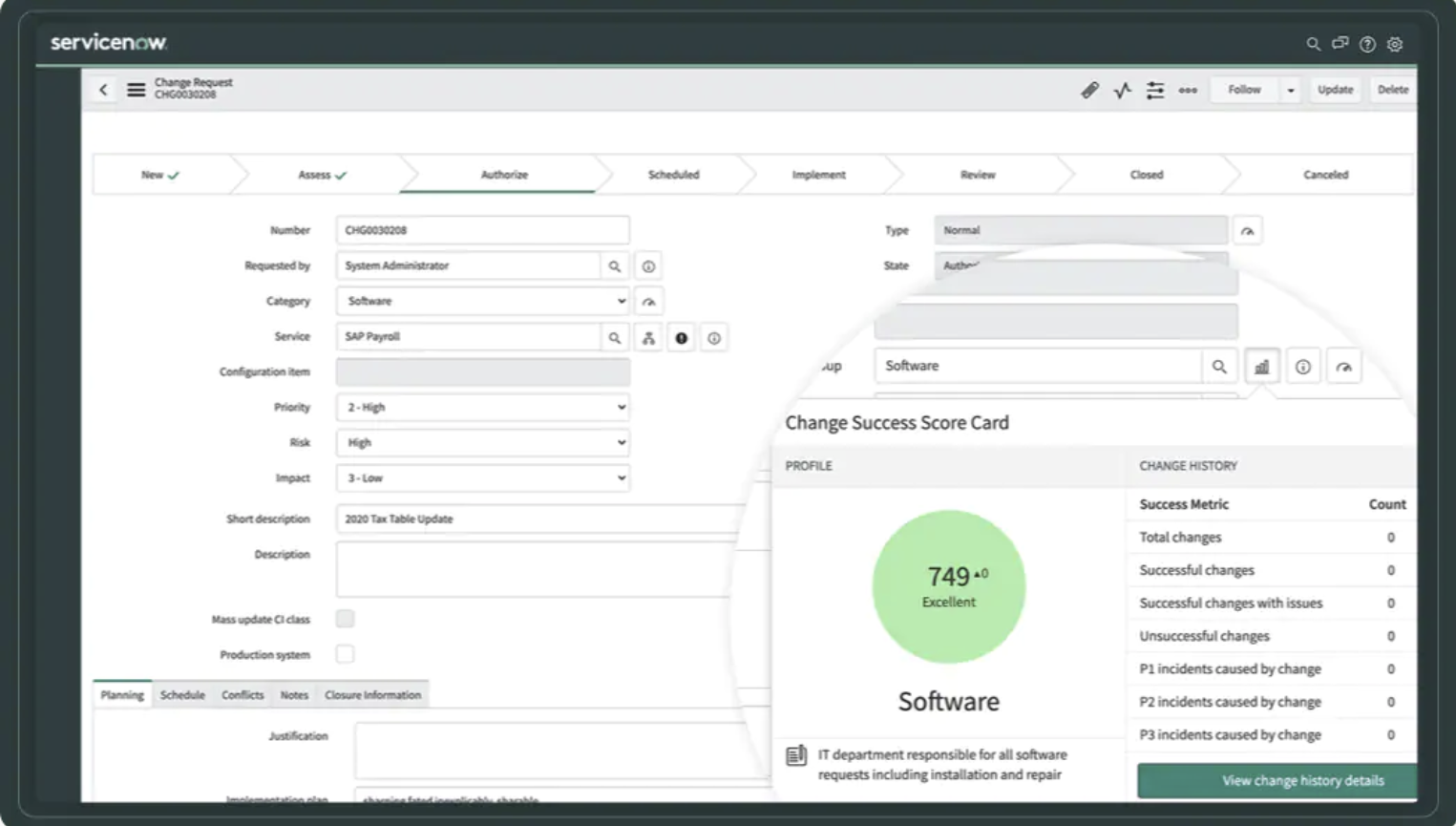
Key Differentiators
- Multimodal change gives change managers a way to tailor change activities and flows to specific use cases using templates configured for any environment
- Change success score uses a numeric score of changes and change submitters to automate approvals for low-risk changes and evaluate probability of success
- Change approval policies help change teams balance velocity, stability, and compliance using individual change conditions
- Risk intelligence uses machine learning similarity algorithms and classification to make data-driven change risk predictions
- AI-assisted change uses “clustering” capability to identify and suggest standard templates
- Configuration Management Database (CMDB) processes change request and release plans for all IT components
- Conflict Scheduling provides a consolidated view of schedules
- Mobile change request and agent views allow teams to have mobile app experiences that facilitate the change process
- Unauthorized change detection automatically notifies change owners of non-documented change activity
- Change-based analytics and reporting contains pre-configured dashboards and visualizations
BMC Helix ITSM
BMC Helix ITSM covers a wide range of IT management functions. On DevOps, users can automatically create issues in agile software tools (like Jira or Azure DevOps) directly from BMC Helix ITSM incidents without manual data entry. They can also create change requests from Jira user stories, or relate multiple Jira user stories to a single ITSM change request. This tool enables DevOps organizations to maximize delivery agility and quality of service while ensuring governance and compliance.
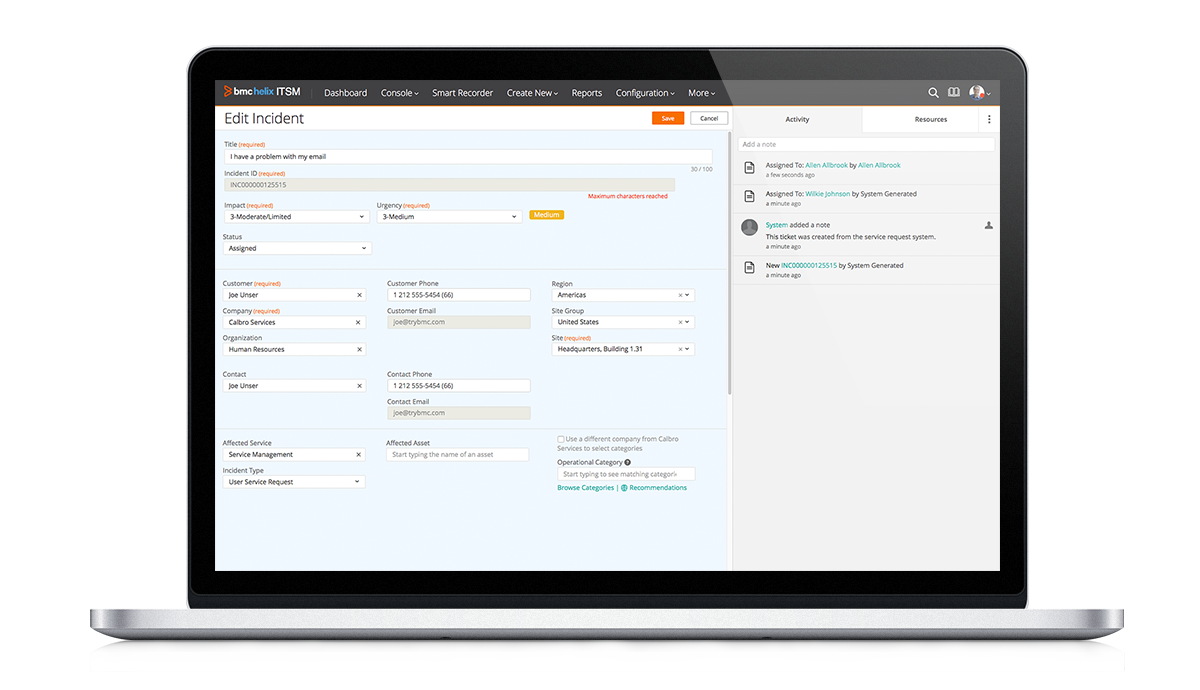
Key Differentiators
- Includes a guided process on mobile and web, drag-and-drop change calendar, automated and contextual collision detection, and impact analysis
- Delivers information needed for agent decisions as well as flexible decisions about automated approvals, based on historic performance of product teams
- Cognitive risk analysis module calculates the risk score for every change that’s being produced from agile development tools like Jira and automatically creates the change request with that score
- Provides swarming capability for agents via ChatOps capabilities in the built-in console or Microsoft Teams
- Provide a single, consolidated catalog for self-service intake, including creating/managing intake of defects from agile software dev tools or allowing automated fulfilment of cloud infrastructure requests
- Automated, rapid provisioning of services to end users, teams, and departments via intelligent chatbots and automation
- Single-pane-of-glass service management for service desks across multi-cloud services, providers, and environments
ManageEngine ServiceDesk Plus
ManageEngine ServiceDesk Plus provides visibility in dealing with IT issues to ensure that businesses suffer no downtime. It includes incident management to reduce outages, improve agent productivity, meet SLAs, and manage the lifecycle of IT tickets, as well as problem management to classify, analyze, and take problems to closure. This tool ensures better end-user satisfaction and better visibility for IT.
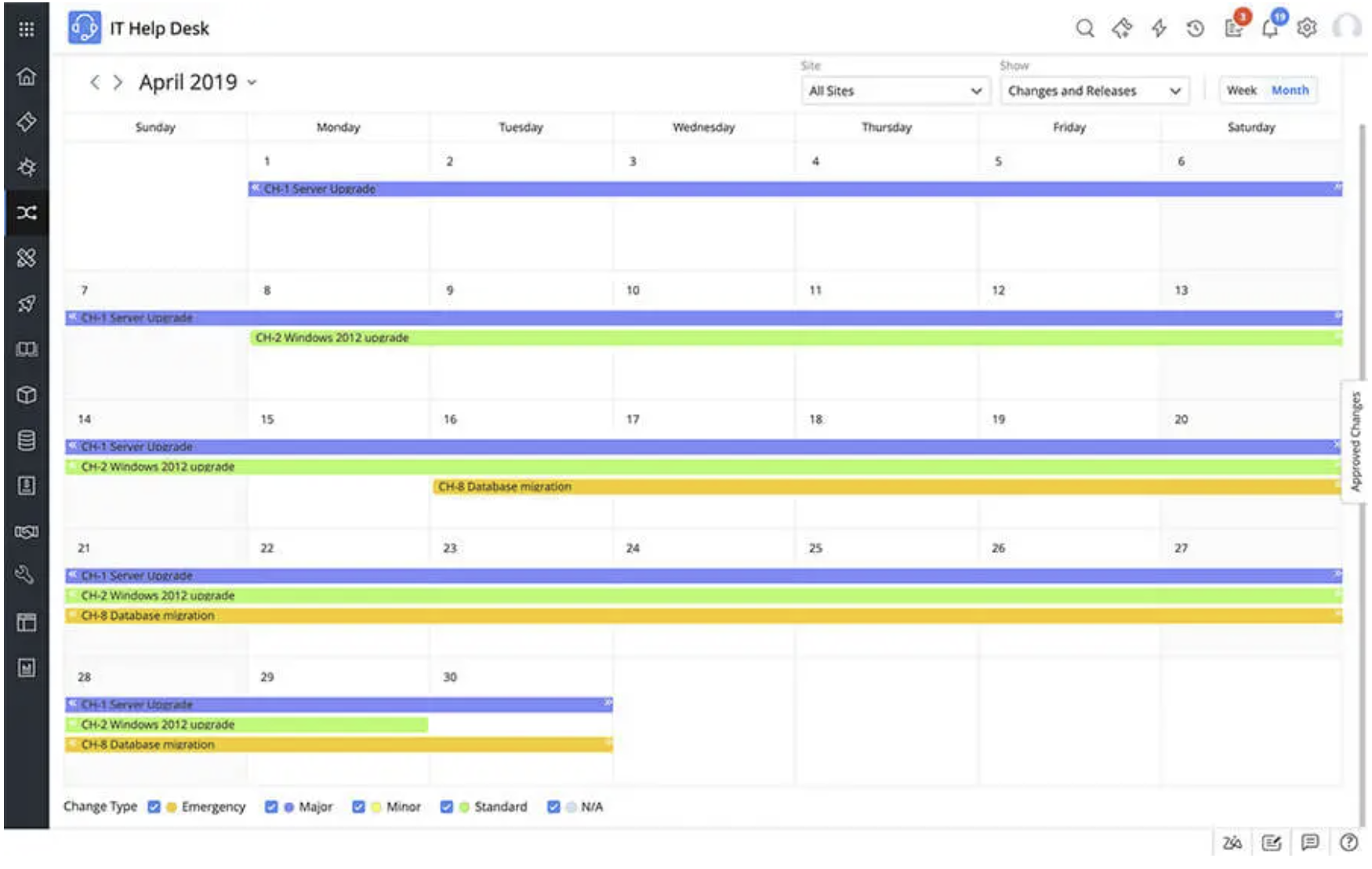
Key Differentiators
- Analyze the root cause and reduce repeat incidents in IT
- Streamline planning, approval, and implementation with automated workflows
- Discover, track, and manage IT hardware and software assets in one place
- Optimize asset utilization, avoid vulnerabilities, and ensure license compliance
- Create and publish your service catalog with custom SLAs and multi-stage approvals
- CMDB to track and manage all configuration items and map their relationships and dependencies
- Visually analyze the impact of changes and outages for informed decision making
FreshWorks Freshservice
FreshWorks Freshservice contains a wide range of IT management functions. It enables IT to modernize employee engagement with integrated support channels and AI-driven service management as well as change management and other capabilities. This platform integrates service management on a single platform to bridge silos, improve time to resolution, reduce costs, and improve visibility.
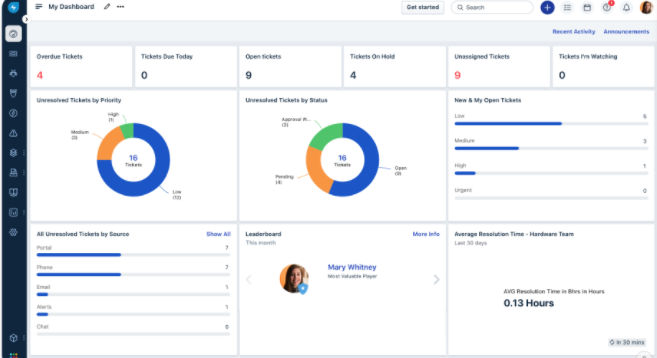
Key Differentiators
- Deploy a change control process that allows for standardization and automation
- Integrate Change Control with the service desk and CMDB to minimize risk
- Eliminate repetitive tasks and manual processes, and drive service efficiency and customizability using no-code workflows and automation
- Onboarding, migration services, and 24/7 support
- Set multiple SLA policies for different business hours or incident categories
- Resolve tickets based on priorities, and automate escalation rules to communicate about SLA violations
- Extend the knowledge base to assist end users and deflect incidents
- Create on-call schedules for agents to manage critical events
- Isolate problems, link them to existing or past incidents, and perform root cause analyses with Freshservice’s timeline of events
SunView ChangeGear
SunView ChangeGear is designed to streamline change and release management processes that enable organizations to meet auditing and compliance requirements. It supports DevOps initiatives by streamlining change processes to reduce release bottlenecks. This system provides an enterprise-wide view into the change schedule to coordinate and track change activity with other planned events within the organization.
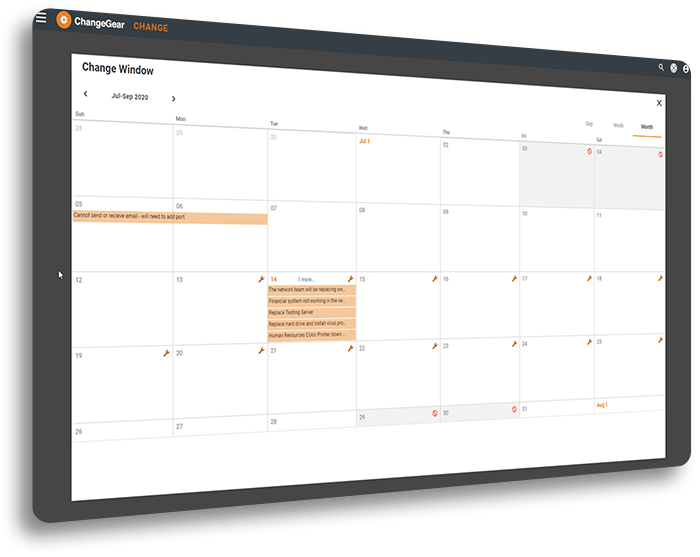
Key Differentiators
- Reduce risks and improve systems availability by automating ITIL change management best practices
- Meet compliance requirements of NERC/CIP, FDA CFR 21, PCI, and others by implementing documented change control processes for non-IT assets
- See planned change events such as Change Windows and Blackout Periods as visual queues on the Change Calendar
- Embed the Change Calendar directly into a Change Request form to make it available for every change
- Speed approvals with pre-authorizations based on team performance
- Automations for approval and routing
- Codeless change model workflows for ITIL, DevOps, and business processes
- Automate the collection of critical risk documentation and change record history
Whatfix
Whatfix is focused on changes such as employee onboarding and offboarding, as well as large-scale adoption of digital technologies. It aims to disrupt application training, learning, and support content by providing contextual, interactive, real-time, and autonomous user guidance.
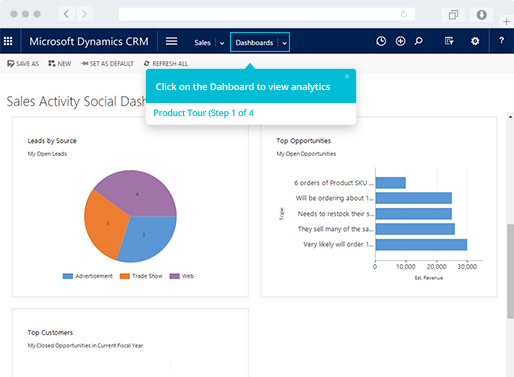
Key Differentiators
- Real-time, in-app help that’s customized to individual roles
- Make training more effective by adding context and relevance to a learner’s experience
- Engage users by showing them the most useful and timely information in-app
- Create content with zero coding
- ISO 27001 and SOC 2 certified, and GDPR compliant
TOPdesk
TOPdesk helps service departments to work together, to connect with users and customers, and deal with all aspects of service management, including some change management functions. With this software, you can see at a glance which changes are in progress, spot possible problems, and manage deadlines.
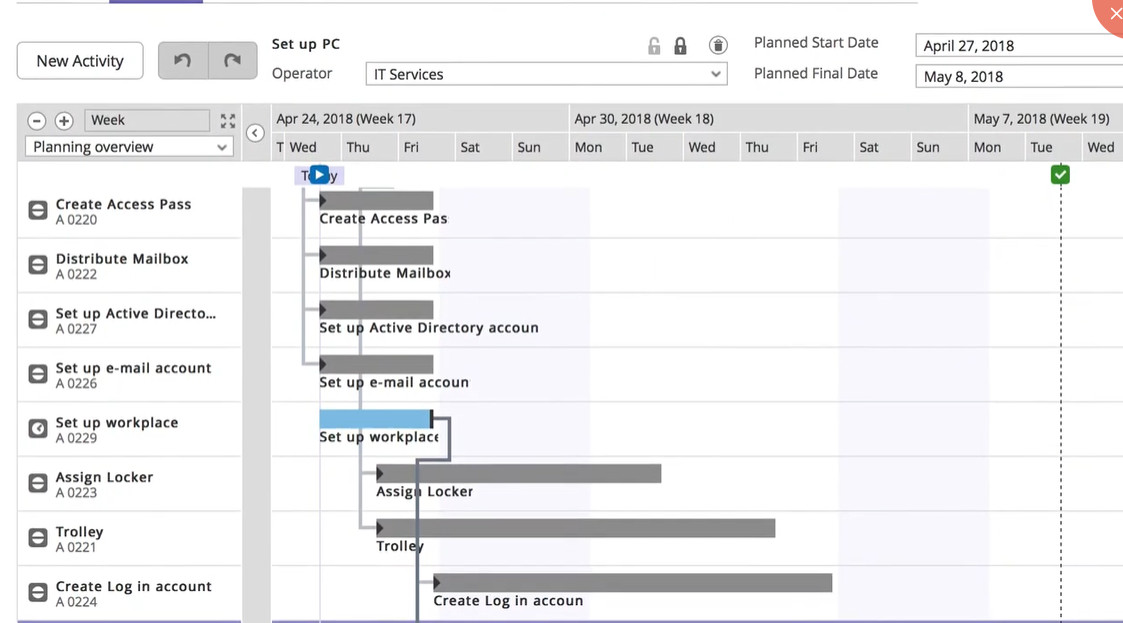
Key Differentiators
- Register recurring processes and procedures in templates to implement standard changes in seconds
- Set up dependencies between activities, as well as authorization moments
- Add change templates to forms
- Change Explorer offers clear overviews of all tasks and workflows
- Once a change is authorized, Change Planner lets you create and edit activities
- TOPdesk’s IT Change Management software is integrated with Configuration Management
- Best practices based on 5,000+ implementations
Key Features of Change Management Tools
Change management tools vary from vendor to vendor. However, several features should be found in most products.
- Change requests to give anyone the ability to request a change and document outcomes.
- Change approval/denial capability with minimum disruptions to everyday work.
- Change risk assessments to determine the risk that a change poses to your IT environment.
- Change policies to provide guidance for how changes should occur, and what the process is for different change types.
- Change scheduling to build out a change calendar that’s used to help mitigate risks of negative outcomes.
- Integration with agile software development tools to reduce the need for manual entry and offer real-time views.
- Intelligent automation for change approvals to enable rapid delivery.
- Intelligent swarming, an emergent support approach that provides better alignment between support functions and DevOps teams. This helps to organize support resources, which is increasingly adopted by support organizations across the industry.
The Benefits of Change Management Tools
There are many benefits realized through the implementation of change management software and tools. These include version control for IT systems and applications, preventing too many people from being able to make modifications, and tracking all the modifications and changes made. Further change management systems allow the rollback of changes that caused problems.
Further, IT can integrate change management into larger IT management packages that also encompass incident management, task management, release management, project management, Service Desk, and more. This reduces silos and improves visibility across IT and enterprise assets.
Read next: Best IT Management Software Solutions 2021